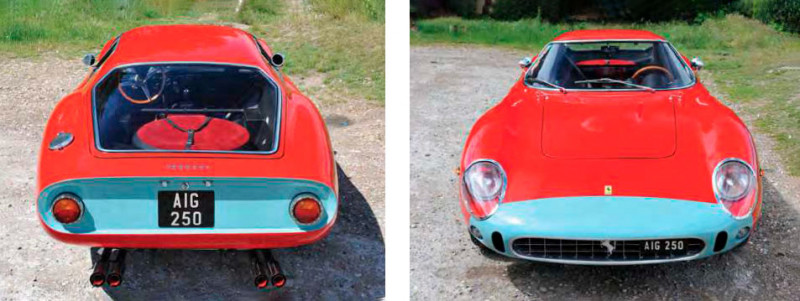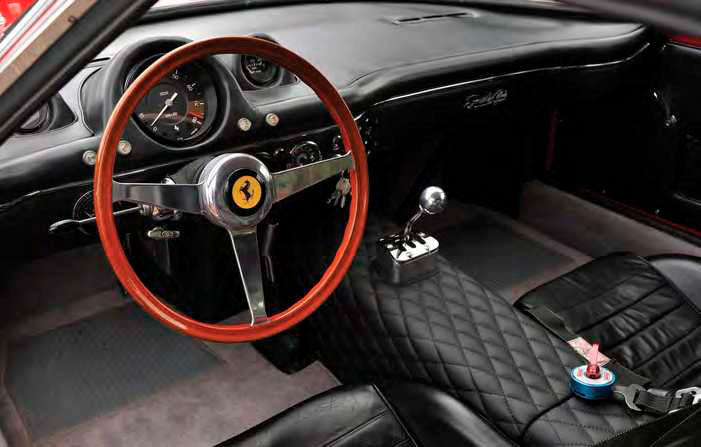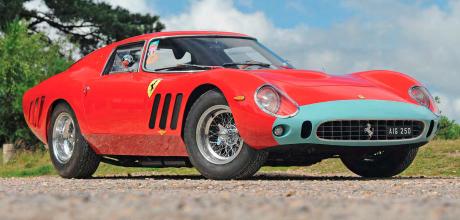1963 Ferrari 250 GT Allegretti - sensational evocation of Drogo’s classic
With distinct 250 GTO vibes, this Ferrari is in some ways even more exotic. We get behind the wheel of a 250 GT-based reincarnation of a famous Drogo-bodied Ferrari 250 GTO.
Story by Chris Rees
Images by Michael Ward
FERRARI ‘DROGO’ 250 GT DRIVEN
1963 Ferrari 250 GT Allegretti — sensational evocation of Drogo’s classic
We hear it coming before we see it. Twelve cylinders purring; straight-cut transmission cogs grinding; brakes squealing. And then it heaves into view: a vision of early 1960s magnificence, painted lustrous red with blue highlights zinging out. Peter Jerram’s superb berlinetta is clearly a Ferrari but it’s hard to put your finger on exactly which one. It’s not a GTO; what on earth is it?

That’s not the easiest question to answer. Let’s start with the car’s designer. Actually, even that’s not straightforward. You see, the design is what’s commonly called a ‘Drogo’, after the coachbuilder Piero Drogo – even though his business was actually called Carrozzeria Sports Cars, not Drogo at all. And he never designed any cars himself. Indeed, virtually nothing that came out of his workshops in Modena from 1960 to 1971 was ever ‘designed’ at all: instead, bodies were simply hammered into shapes that highly skilled craftsmen made up on the spot.

And it’s one of these craftsmen who shaped this car: Mario Allegretti. But even though we’ve hardly begun, already our story takes a turn; for this body was not made in the early 1960s, but instead in the 1980s. The car you see on these pages is in fact a 1986 replica of a body that signor Allegretti did in 1965.

OK, let’s rewind a bit and address that original 1965 car, which has become known as the ‘Norinder’ car after its Swedish owner, Ulf Norinder. He had purchased Ferrari 250 GTO chassis #3445GT from Count Volpi's Scuderia SSS in 1963. Painted in distinctive Swedish blue-and-yellow livery, it did well in competition, including sixth place overall at the 1963 Targa Florio. After its racing days were over, Norinder decided to give it a new body and approached Piero Drogo, who was the acknowledged master at rebodying damaged Ferraris. In 1965, Carrozzeria Sports Cars duly created stunning new coupe bodywork on the GTO chassis, painted midnight blue. But a mere decade later, the unique Drogo berlinetta was crashed by its then owner, Robert Lamplough. It was decided at that point to convert the car back to a 250 GTO using replica Scaglietti bodywork by Mario Allegretti – yes, the same master panel beater who had made the 1965 rebody.
The crashed #3445GT Drogo body was apparently left in a corner of Allegretti’s workshop until Ian Webb bought it and took it to UK-based Ferrari specialist, Terry Hoyle, in 1987. Duly repaired, the Drogo body was mounted on a shortened Ferrari 250 GT 2+2 chassis (#2423GT), which exists to this day.

At around the same time – it’s believed in 1986 – another 250 GT 2+2 chassis (#4769GT) was at Allegretti’s workshop. This chassis was originally delivered to an Italian customer in 1963, but by the 1980s it was in the hands of Ferrari collector Glen Kalil of Palm City, Florida. It was Kalil who commissioned Allegretti to craft an exact replica of the 3445 Norinder Drogo on this chassis, which was done by Mario and his son, Stefano. It’s this car that you see on these pages: essentially a mid-1980s 250 GT-based replica of a Drogo-bodied 250 GTO, built by the same man who did both.
Peter Jerram came to own this car because he was looking to divest himself of his Ferrari 212 and approached the Old Racing Car Company in Norfolk to commission a sale. At the time, Roy Kent at ORC was the owner of the Drogo but wasn’t using it much.

He was toying with the idea of campaigning it at Goodwood Revival but realised that it would need significant alterations to turn it into a racer, so would Peter be interested in swapping his race-ready 212? “I’d seen the Drogo at shows before, drove it and got a good feel for it, and decided to do the swap,” says Peter. “It had been in the USA for most of its life, owned for a long time by the well-known collector, Roger Willbanks of Denver, Colorado. It passed through several other hands before arriving in the UK in 2014.”
It certainly looks the part. The Drogo shape has distinct echoes of the 1964 250 GTO, with perhaps elements of 275 GTB, too. Yet it has many unique features, including a distinct crease at sill level and a rear roofline that forms an elegant fastback. The quality is clearly excellent: impeccable shut lines, aluminium panelwork of the highest quality and red paint that you’d never guess is untouched from the 1980s. Currently 4769 has light blue highlights on the front of the nosecone and the indent on the Kamm tail – a nod to the period racing livery of Colonel Ronnie Hoare’s Maranello Concessionaires, the UK Ferrari importer. The bolt-on mirrors are non-original and perhaps a bit out of place, but kind of necessary.

Underneath, this car is essentially a Ferrari 250 GT 2+2, although significant modifications had to be carried out to the chassis in order to receive the new bodywork. It’s thought that the body was built using the original buck for the Norinder car. Indeed, according to a latter sent by Anthony Kalil, the son of Glen Kalil, to Ferrari historian Marcel Massini, the original nose of the 3445 body was used. Anthony said: “I remember meeting Mario with my father and mother, who all travelled over to visit him at his shop. When I first saw his shop in 1986, he had sections of the first Drogo 3445 nose that was removed from a minor accident. It was still dark blue… My father inquired about the piece, just because of the colour. To Mario's delight, he began to tell us about the Drogo car… As the Drogo was beautiful, we sent [our 250 GT 2+2] over to have it created. The original nose of the 3445 body was used.” Peter Jerram has since been in touch with Anthony Kalil, who is hopefully going to assist with piecing together more of the car’s secrets.
One difference over 3445 (as it is now) is that 4769 has sliding side windows. 3445 was later modified with wind-up windows, but 4769 replicates the original style, echoing the 250 GTO’s sliding-window arrangement. Although 3445 was built as a one-off, several other cars have since been bodied in this same basic style, in addition to Peter’s 4769. Chassis #2423 GT is the best known. This uses the original damaged 3445 body, which was retained by Allegretti and bought by Ian Webb. He brought it to the UK, where Ferrari specialist Terry Hoyle fixed it and put it on 250 GT 2+2 chassis 2423. The engine and suspension were upgraded to 250 GTO specification at the same time – which was 1987, just after Peter’s car was built. Other lookalikes of 3445 include chassis #1257GT (by Allegretti but not an exact copy, unlike 4769) and two further examples created by Terry Hoyle (#3213 and #3881).
As bought by Peter, the car had no badges at all but having located some original Carrozzeria Sports Cars badges in Modena (for a substantial sum), Peter couldn’t resist fitting them on the front wings. “I also connected with Stuart Passey who owned another Drogo Ferrari, the ugly Tadini-designed 250 GT, which has now been converted to a 250 GT SWB. He kept the elegant ‘Sports Cars Modena’ badge, which now sits on my dashboard.” As we’ve said, 4769 is not the only replica of the 3445 original but it is – according to the authors of the definitive book about Drogo, Jack Koobs de Hartog and Marc de Rijck – “undoubtedly the best of all 3445 replicas because not only the exterior but also the interior was replicated”.
Speaking of which, the cabin looks superb, if a little eccentric. Drogo’s concept was to mount a very large rev counter directly ahead of the driver, with smaller water and oil temperature gauges to either side, plus fuel and oil pressure gauges below. There was no speedometer (!) so a modern gauge has been added as a temporary measure while Peter gets Speedy Cables to replicate a new speedo in the style of the rev counter, which he plans to mount on the transmission tunnel.
The low-back bucket seats are fixed in position with no adjustment in any direction (luckily I’m the same height as Peter). To achieve a comfortable arms-out driving position, Peter had to remove two of the three spacers he found fitted behind the steering wheel. The passenger has to splay their feet around a strut bar in the footwell – but as Peter says, “It’s not a passenger seat so much as a mechanic’s seat!” However, the car’s usefulness as a track machine is somewhat compromised by the roofline being so low that you can barely wear a helmet…
Driving any Ferrari 250 GT is a special experience but this one is unique – not because it’s a Drogo but because, says Peter, “It’s really set up for the track.” A grand tourer this car is not; indeed, it’s the most mechanical-feeling 250 I’ve ever piloted. With its six-carb set-up, the V12 engine is much as you’d expect – a gloriously smooth purr with the capacity to raise your neck hairs as the revs climb, the redlined SNAP exhausts giving the soundtrack a racy edge. However, the effort of achieving high revs is substantial, as the accelerator pedal feels like it has Charles Atlas Bullworker springing.
The same comment applies to the clutch pedal – the word heavy doesn’t begin to do it justice – while the open-gate dog-leg five-speed gearbox has an ultra-mechanical change quality, with a very long first gear but very close-set ratios beyond. The non-synchro straight-cut gearbox is, frankly, very challenging for road use: sometimes awkward to engage, requiring double-declutches up and down, and sounding like a bag of nails caught in a tornado. Refinement? There is none. Small wonder that Peter is considering swapping the ’box out for a rebuilt GTO unit with full synchromesh.
More evidence of the track set-up comes as soon as you apply the brakes: they’re massively effective but the racing pads squeal like pigs at an abattoir. I was expecting the steering to require similar quantities of manliness to manipulate as the pedals but in fact it’s not heavy at all (“lighter than my 512 Berlinetta Boxer!” laughs Peter). The turning circle, however, is mighty wide.
Despite very high 70-profile rubber (Michelin XWX, 215 wide up front, 225 at the rear) surrounding the 15-inch Borrani knock-off wheels, the ride is very stiff, with every bump transmitted to your posterior, and also your fingers via the steering wheel. For the road, it’s a bit of a beast but I suspect that on a track, it’d feel right at home. I guess that means you’ll need to look out for it on a circuit near you soon.
Racing character is very much felt when driving – this is a butch, mechanical monster of a machine. Aluminium body by Allegretti looks amazing. Odd dashboard design puts rev counter centre stage.



Where is the Dino Berlinetta?
Great fun reading your latest issue, including the ‘Drogo’ pair of Ferraris and your Scottish jaunt. Perhaps you can assist with this strange mystery.
At the 1967 Turin Show, Pininfarina exhibited a breathtaking Leonardo Fioravanti-designed derivative of the Fiat Dino Spider in the style of a Berlinetta, painted in metallic blue. This subsequently did the rounds of the European shows and was very well received, but no further examples were built. With the advent of the 2.4, the same car was slightly modified (grille, bumpers) and painted yellow – Pininfarina’s then preferred shade for show cars – even though the engine wasn’t changed!
After that, it vanished and, according to someone I knew in Turin, even Pininfarina had no knowledge of its whereabouts. If it was appropriated, someone is sitting on a gem. Incidentally, the curious Pininfarina Parigi ‘Breadvan’ and Ginevra 2.0-litre Dino line-studies, penned by Paolo Martin, were variations on the same chassis. Rumours of four Ginevra models being built are just that.
As in the ‘Drogo’ articles, the Dino Berlinetta story has a couple of twists. At the Lancia Gamma launch in Portofino, I had a lengthy chat with the ‘father’ of the Gamma, Sergio Camuffo, who had more than a passing soft spot for Fiat Dinos. He recounted that two brothers, whom he knew, had apparently asked Pininfarina to convert their Dino Spiders into Berlinettas but, sadly, nothing more was known. As the photos show, that one-off Berlinetta is one of the most beautifully balanced designs.